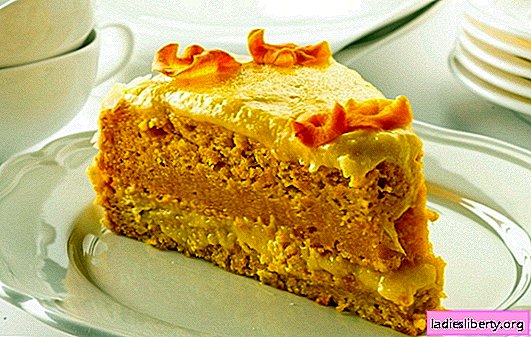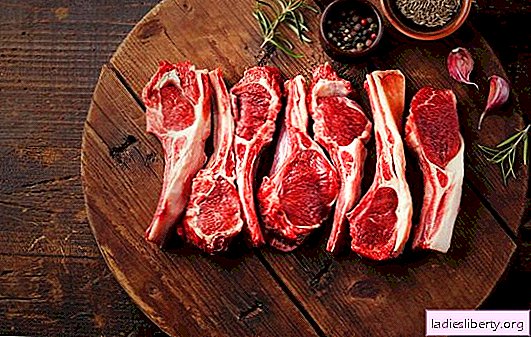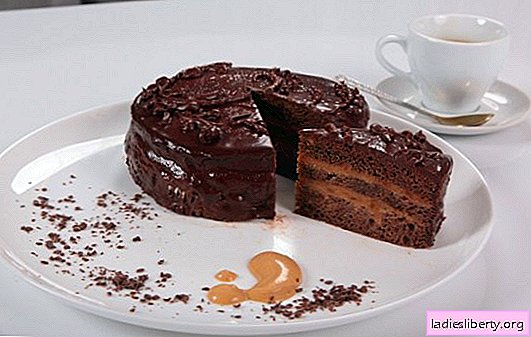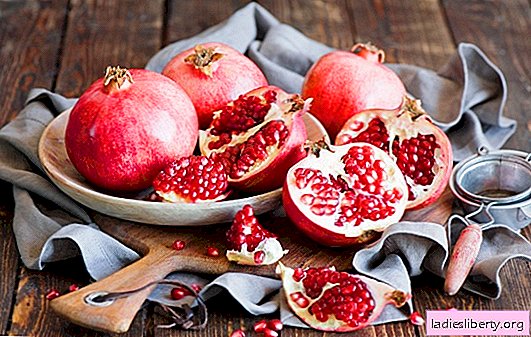
The reasons for not consuming animal products may be different. But what about sweet pastries, where eggs, milk, cream, butter and cottage cheese are almost always present?
Does rejection of animal fats and proteins really mean farewell to the “sweet life”?
Lean cake at home - general principles of cooking
There are a staggering number of recipes for cakes and other pastries with ingredients of animal origin, but for people who are on a diet, staunch vegetarians, fasting on religious beliefs, it is not so simple.
Conventional confectionery and pastries, according to the recipe and cooking technology, among other ingredients, include:
- Milk;
- Cottage cheese;
- Butter;
- Cream;
- Eggs
- Gelatin.
For lean baking, these products are unacceptable, but sweets, however, are not excluded from the diet. Among plant products, you can choose a replacement for animal fats and proteins, with the same physical and biochemical properties, so that there are as many recipes for cooking lean cake at home.
The food industry has developed and produced a number of special products that replace, for example, milk and dairy products:
- almond,
- coconut,
- soybeans
- peanut,
- linen,
- seaweed.
From these plants get butter, milk, cream, cottage cheese, since their biochemical composition is close to the content of proteins, fats and essential amino acids in dairy products of animal origin. These products can be purchased or prepared on their own, but in this case, baking a lean cake at home will take longer.
Can be used to make dough. any refined vegetable oilavailable in the kitchen. The main condition for the use of unrefined oil: its smell should harmoniously complement the aroma of the confectionery. If nuts are present in a lean cake, you can safely add the same butter to the dough.
For creams in a lean cake, it is better to use coconut oil made in an industrial setting. It has sufficient fat content, which will provide the cream with the desired structure, similar in appearance to a creamy (natural) cream.
The next point: in any baking, gelatin is often used, which, as you know, is of animal origin. You can replace it agar agarmade from algae. In addition, two or three egg whites can be replaced with an aqueous agar solution, in a ratio of one to two: agar - 1 part, water - 2 parts. So you can get an analog of protein-nut (air) dough or protein cream.
The porous and magnificent structure of the test in lean baking can provide baking powder, ammonium, baking powder or ordinary baking soda, slaked with vinegar or any acidic juice - for baking, it is better to use lemon juice, neutral in taste and smell.
An important point: if you use baking soda as a baking powder, then remember that its excess, in addition to the volume, will give the test a specific flavor, which is not very pleasant, and the dough will turn out dark and dry. To prevent this, use soda in combination with ammonium (1: 1). All baking powder should be added as a last resort, before sending the test to the oven: it is necessary to ensure that the baking powder reaction ends at the moment when the product is already covered with a golden brown. This will ensure maximum baking.
To achieve the humidity of the finished dough, you can use, in addition to water or coconut (soy) milk fruit or vegetable purees (apples, bananas, pumpkin, carrots).
Any cake should have a flavor characteristic of a confectionery product, so without using vanilla, cinnamon, cocoa, citrus not enough. Especially these components will help to neutralize undesirable odors of baking powder, which in ordinary, non-lean, baking helps to hide milk proteins and fats of animal origin. Therefore, the volume of all plant fragrances, to improve the taste, in lean products is better to increase, at least one and a half times.
Recipe 1. Lean cake at home, with chocolate marshmallows in chocolate
For shortcakes:
• Wheat flour 250 - 300 g
• Flour, potato 75-80 g
• Vanilla 5 g
• Cocoa (80%) 150 g
• Zest, orange 20 g (fresh)
• Sugar 75 g
• Ammonium - 10 g
• Baking powder 30 g
• Peanut Butter100 ml
• Milk, soybean - 300 ml
• Salt
For impregnation:
• Orange syrup 300 ml
For a layer of apple marshmallows:
• 150 ml - water
• 750 g - sugar
• 6 pcs. - large apples
• 30 g - agar
• Vanilla or orange zest
For glaze:
• Soy cream 50-70 ml
• Chocolate, bitter 200 g
• Coconut oil 70 g
• Sugar - 80 g
• Vanilla 2 g
Order of preparation:
Before starting work, preheat the oven and prepare a baking dish. Combine flour, sugar and cocoa powder and mix.
Pour oil into a separate bowl and, whipping it with a whisk, gradually add milk, without stopping whipping.
Add the zest of orange and vanilla. Into the resulting mass, add one spoonful of flour mixed with sugar and cocoa powder.
Ammonium and baking powder should be added to the dough immediately before being sent to the oven.
The readiness of the baked cake is checked with a match.
It can be removed from the mold and cut after complete cooling. Divide into two layers and saturate the cakes with chilled orange syrup made from natural juice and an equal amount of sugar.
Leave them for 4-5 hours to proof.
We prepare marshmallows for spreading cakes. Soak 25 g of agar in water (150 ml), and when it swells, melt in a water bath. Bake 6 apples (can be in the microwave) and make mashed potatoes from them, removing the core and peel. In applesauce, add 350 g of sugar and 1/3 of the melted agar (we introduce the agar solution instead of egg white). Beat until lush. Flavor orange zest or vanilla. In the remaining part of the dissolved agar, we introduce the second half of sugar to prepare marshmallows, and boil the syrup until the filament forms, continuously stirring it in a water bath.
Hot syrup must be injected in mashed potatoes in a thin stream, whisking until stable peaks. Part of the finished marshmallow spread on the lower cake. Squeeze the remaining mass onto parchment paper sprinkled with powdered sugar using a pastry bag and a large curly nozzle. When the marshmallows laid out on the cake, harden a little, lay the second cake on it and cover the cake with glaze. To do this, boil soy cream, melt sugar, coconut oil and chocolate. You can cover the cake with warm glaze so as not to melt the marshmallows. To decorate, put on the surface of the cake marshmallow, planted on parchment. Top it with a thin string of chocolate glaze. Garnish the surface with berries.
Recipe 2. Lenten cake at home, sand with orange and pumpkin souffle
For the cake:
• A mixture of flour (whole grain and premium) 350 - 400 g
• Fresh, orange 150 ml
• Zest, orange 50 g
• Unrefined sugar 300 g (and 70 g for dough)
• Water 150 ml
• Ammonium powder 20 g
• Agar - 40 g
• Oil, coconut (food) 150 g
• Vanilla 3 g
• Coconut or chocolate chips.
• Pumpkin puree 200 g
Order of preparation:
Take a baking bag and pour 1.5-2 kg of peas into it and tie so that the cereal does not spill out. Send the form, oiled, with parchment paper. Preheat the oven to 180 - 200 ° C. Getting to the test:
Pour the oil into the blender and, gradually adding water to it (always ice!), Beat it with sugar and water at high speed. Pour the mixture of flour, salt, sugar and vanilla powder onto the work surface. Gradually adding an oil emulsion, knead the dough. The rolled dough sheet should be larger than the diameter of the mold so that it covers the rim. Transfer the dough into a mold, put a bag of peas on top and send to the oven.
Pour agar agar with orange juice. In mashed pumpkin, grated on a fine grater, pour sugar and zest of fresh orange. Fry until soft in a saucepan. To prevent burning, add some water and coconut oil. Boil the juice with agar until thickened, and then pour it into pumpkin puree, whisking until smooth and lush.
Cool the baked “basket” of dough in the form, fill it with pumpkin-orange souffle. The cake will be tastier if the night stands. Therefore, bake it better on the eve.
Recipe 3. Lean cake at home with fruit
For the cake:
• Oranges 2 pcs.
• Pineapple rings ½ can
• Soda10 g.
• Lemon ½ pcs.
• Jam (any) - for impregnation of cakes
• Starch 25 g.
• Cashew nut, fried 150 g
• Butter, peanut 50 ml
• Kiwi 1 pc.
• Unrefined sugar 220 g
• Grapes (berries) 200 g
• Wheat flour 250 g
• Milk, coconut (or almond, soy) 200 ml
• Agar 50 g
• Vanilla powder 4 g
Cooking:
Squeeze juice from citruses (250 ml), after removing zest from them. Pour fresh and 50 ml of peanut butter into a blender. Add starch, half sugar, salt and zest of fresh oranges. Beat the mass at high speed. Switching the blender to the minimum speed, pour the flour. When the dough is almost ready, add a teaspoon of soda, mix and pour it on a baking tray (or in a pan). Put the cake out of the mold on a napkin, turning it over. Leave wrapped for half an hour.
For cream, pour 100 g of cashews into a blender, the same amount of sugar, add vanillin and salt. Dissolve agar-agar in water (250 ml) and let it boil. Pour the hot mass into a blender, nuts and milk, and turn it on to beat at maximum speed. In the meantime, cut the cooled cake in half and grease the lower layer with jam and cover with the upper part of the cake. In a deep detachable form, we beautifully lay the peeled and cut fruits. Pour them on top with cream whipped in a blender, and on top of it lay out the pieces of cake that are connected by jam. We send the finished cake for proofing in the cold. When the agar agar hardens, put the cake on a dish, turning it over.
Recipe 4. Lean cake at home with berry jelly, without baking
For the cake:
Cookies 400 g
Oil, vegan (any) 50 g
Vanilla
Soybean milk 200 - 250 ml
Berry jelly (redcurrant, gooseberry) 300 g
Agar 70 g
Cooking:
For this lean cake at home, any vegan cookies (without milk and eggs) that can be seen on supermarket shelves are suitable.
The recipe is whipped up. If in homemade preparations there are a couple of jars of gelled juice, then this cake can be prepared in 20 minutes.
Mix milk and butter in a blender. If the cookies are not sweet, but you want to make the cake sweeter, add sugar to the milk. A little vanilla to create the flavor of a real cake. Half of the agar specified in the recipe is diluted in 100 ml of water, boiled, added to coconut milk with butter. Throw pieces of cookies into the liquid mass without turning off the blender. We lay out the homogeneous mass in a detachable form and level the surface. Spread your favorite berries or fruits on top, pour the jelly from the jar into the mold and put it in the cold to set. If the jelly in the jars is not dense enough and there is no certainty that it will maintain the desired shape, then add pre-dissolved agar to it, bring it to a boil and pour it into the mold already warm.
Recipe 5. Lean cake at home, puff with custard
For the cake:
• Flour 0.5 kg (approximately)
• Milk, soy 1 l
• Soda 4 tsp. L.
• Juice, lime
• Water
• Coconut oil 150 g
• Vanilla
• Sugar 300 g
• Ground nuts (any) 250 - 350 g
Cooking:
Sift the flour (about 400 g) onto the work surface, make a recess. Pour soda into a cup with lime (lemon) juice. When the hiss stops, put the soda in the flour. Add 4-5 tablespoons of coconut oil. For the test, you can use any vegetable oil with a neutral smell, but the dough should be fat. We do not add sugar to the dough. Knead the dough, as for noodles. First, the oil is mixed, and then water is poured, as necessary. Cut the dough into 8 identical pieces, first roll them into a ball, and then work with a rolling pin, making very thin, almost transparent, round sheets. The remaining flour is used for rolling the dough. Bake one sheet in a very hot oven. Leave for cooling and prepare the cream. Pour milk into a pan (non-stick), add sugar and vanilla. In a small amount of milk, we dilute 3 full tablespoons of flour, and when the milk boils in a pan, pour in the second part, without stopping intensive stirring in the pan. We cook at the very minimum heat until a thick mass is formed, set aside from the stove for cooling. Add coconut oil to the cooled mass and beat until tender. We grease each layer with cream, crush roasted and chopped nuts. Cake need at least 12 hours to stand, for impregnation.
Recipe 6. Lean cake at home, cream biscuit
For biscuit:
• Sugar 180 g
• Oil 150 ml
• Wheat flour 400 g
• Natural apple juice 250 ml
• Soda 20 g
• Ammonium 15 g
• Vanilla
For cream:
• Semka 3 table. Spoons
• Coconut oil 100 ml
• Sugar 180 g
• Vanilla
• Juice, natural (peach) 300 ml
Cooking:
We begin by preparing baking dishes for biscuit cake and preheating the oven. Prepare an emulsion from juice and oil. Mix all the loose components to a homogeneous mass and introduce the dry mixture into the emulsion, continuously stirring the dough from the bottom up. Immediately pour into the mold and quickly send to the oven.
To prepare the cream, boil the juice with sugar and vanilla. Pour semolina into boiling liquid, stirring, cook until thickened. When the mixture cools, add oil, whisk until tender. Cream, increasing in volume, should acquire a slightly yellowish tint. We smear both parts of the biscuit with cream and form a cake. Decoration can be any fruit or berries.
Recipe 7. Lean cake at home, carrot and orange
For the cake:
• Flour 200 - 250 g
• Walnut, walnut - 150 g
• Granulated sugar 200 g
• Salt
• Vanilla 2 g
• Baking powder 25 g
• Grated carrots 150 g
• Oil, vegetable (odorless) 140 g
• Orange juice, with pulp, - 250 ml
• Orange zest
For cream:
• Chocolate, bitter 100 g
• Unrefined sugar 220 g
• Coconut oil 140 g
• Vanilla
• Coconut milk (or almond) 250 ml
• Fried flour 120 g
Cooking method:
Fry nuts (in a dry pan). Oil (any vegetable, odorless) to combine with sugar, juice; add grated carrots and orange zest, chopped walnut. Pour vanilla and baking powder into the flour, mix well. Combine the dry and liquid mass, pour it into a pre-prepared form. At 200 degrees, bake for 40 minutes.
In a glass of vegan milk with sugar and vanilla, add flour roasted to a cream-colored color (fry without butter) and pieces of natural, dark chocolate. Cook the mass to a thick consistency, stirring continuously. When the cream has cooled, add coconut oil and beat with a mixer.
Divide the crust in half and coat inside and out with chocolate cream. Garnish with fruits and nuts.
Recipe 8. Lenten cake at home "Harmony"
For the cake:
Honey 70 g
Unrefined sugar 200 g
Citrus zest, fresh 40-50g
Cocoa 50 g
Chopped nuts 70-80 g
Vanilla (crystals) 5 g
Oil 120 ml
Sifted flour (wheat) 400 g
Raisins 90 g
Warm water (up to 40 degrees) 200 ml
Baking powder (or ammonium) 50 g
Interlayer:
Jam 200 g
For decor:
Chocolate, black (bitter)
Sesame
Glaze, white
Confectionery sugar (topping for apiaries)
Cooking:
Combine water, butter and sugar in a deep bowl. Heat them to 40 degrees, but do not boil. Dissolve honey in a heated mixture. In a separate container, combine the dry ingredients and pour the heated liquid into the dry mixture. You should get a creamy dough. We pour it into a detachable form lined with parchment. After proofing, we divide the baked cakes into two parts and generously cover the cake with jam or jam in the section. We combine the cakes and pour the top with molten chocolate, sugar icing. Sprinkle the chocolate part with sesame seeds on top, and the white part with glaze with colored sugar sprinkles.
Lean cake at home - tricks and tips
• If you combine wheat flour with a spoonful of starch and a spoonful of semolina, the product will turn out to be moist and porous. For lean baking, it is also better to use a mixture of flour of different varieties.
• A tablespoon of ground white flax seed soaked in three tablespoons of water will replace the egg in the dough.
• Do not rush to remove the finished product from the mold. Wait for it to cool in shape. Cover with a dry cloth on top, and lay wet under the form. Any yeast-free dough in this case will retain freshness for a long time.
• Do not rush to throw away the burnt cake: rub it with a fine grater to remove the burnt layer.
• Depending on storage conditions, the flour may have varying degrees of moisture. Therefore, strictly adhere to the amount indicated in the recipe is not necessary. Focus on organoleptic methods for determining its amount in the recipe.
• Excess sugar often makes the dough not sweeter, but harder. The dough does not rise well, and the finished product turns out to be dry, hard and "rubber". Remember that excessive consumption of sugar is harmful to the body. In addition, taste buds in the mouth do not respond to the amount of sugar in the food, but to its presence in general. Add this ingredient in reasonable amounts so that the cake or pie is airy, and sprinkle powdered sugar on top of the product to make it appear very sweet.











